By Bill Gustin and Enrique Perea
Miami-Dade (FL) Fire Rescue (MDFR) has designed and built firefighter training props to instruct personnel on techniques for cutting laminated impact-resistant glass, vacant property security panels, carriage bolts, HUD window coverings, hurricane shutters, and overhead doors. MDFR has established alliances with window and door contractors to obtain doors and windows with laminated glass as well as overhead rolling, sectional, and overhead sheet-curtain doors. Although most overhead doors are old ones that have been replaced with new doors, most of the laminated glass doors and windows are brand new; they could not be installed because they were the wrong size or design specified by an architect.
Videos: Impact-Resistant Glass-Cutting Training Props
For years, MDFR firefighters would attempt to rig C clamps or otherwise steady laminated glass doors and windows upright while personnel swung axes and mauls or operated power saws to penetrate them. Fortunately, no one was ever injured, but no one was aware of the most significant risk in cutting glass. It wasn’t until Palm Beach County (FL) Fire Rescue filmed a training video that both departments learned of the respiratory hazard of inhaling glass dust. During the production, videographers would freeze-frame the video and magnify images. What was observed was disturbing: Glass dust could be seen entering firefighters’ mouths and noses when they inhaled. As a result, both Palm Beach County and MDFR required that personnel in proximity to glass cutting must operate using self-contained breathing apparatus (SCBA).
In photo 1, the framework for the stationary glass cutting prop has been welded together by its designer, Captain Juan Miguel. To clamp the doors and windows, U clamps were fashioned out of heavy channel iron and equipped with a T-handled screw. The U clamps secure the glass door or window to a bottom sill and to a top header that slides up and down in the channels of the upright supports, like an overhead rolling door. Hence, the prop has the unique ability to accommodate almost any size window or door. In photo 2, MDFR personnel practice cutting techniques using (from right to left) a battery-powered rotary saw, a gasoline-powered rotary saw, and a reciprocating saw. Photo 3 is a close-up of the channel for the top header and of a pulley added to facilitate raising and lowering the top header. Photo 4 shows the expanded prop that incorporates a column of exterior stairs.

(1) Photos 1-8, 13-14 by Miami-Dade Fire Rescue; photos 9-12 by Corey Logan.

(2)

(3)

(4)
Portable Prop Ideal for Acquired Structures
A second portable prop can be mounted in window openings of MDFR’s training tower or in acquired structures for training on vent-enter-isolate-search (VEIS) techniques. The prop uses signposts on the inside and outside of window openings. Ratchet straps squeeze the signposts together to hold them in place. In photo 5, the window to be cut is positioned in the U clamp, secured to the bottom of the outside signposts. In photo 6, the top of the window is clamped by U clamps that engage the outer flanges of the signposts and slide down into position. In photo 7, a firefighter uses a battery-powered saw to cut a laminated glass window held in the window opening of an acquired structure by the portable prop. In photo 8, the portable glass cutting prop is secured in the window with signposts and ratchet straps. Here, a firefighter on the tip of an aerial ladder begins to cut the glass to initiate VEIS.

(5)

(6)

(7)
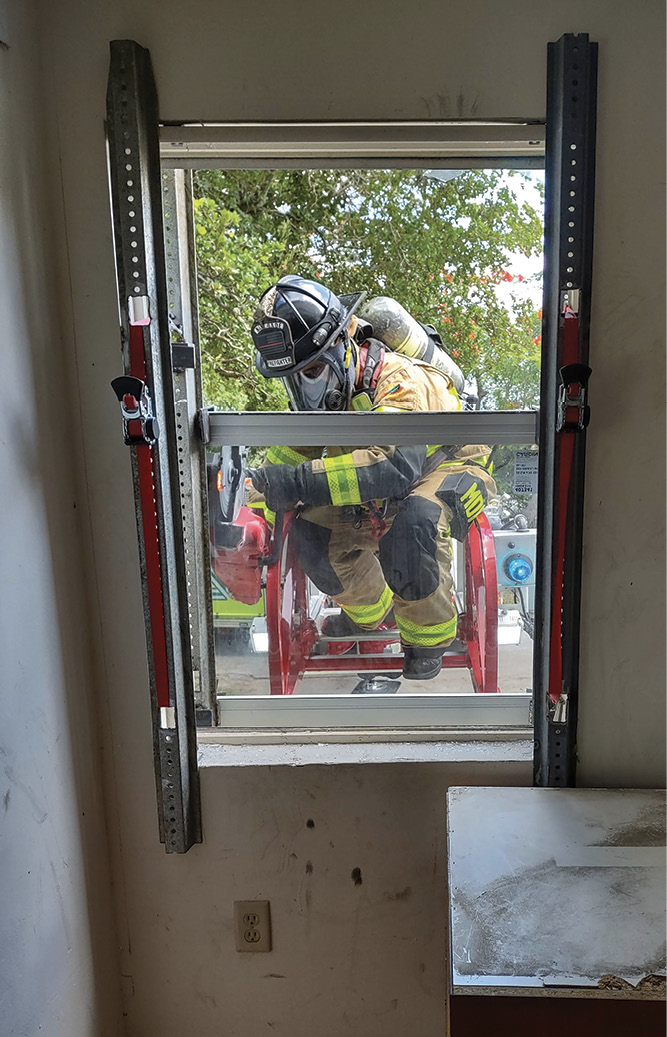
(8)
Glass Types and Properties
An examination of glass-cutting props would not be complete without an examination of glass. Annealed glass is the most common glass firefighters encounter—e.g., plate glass and “float glass.” When impacted by or exposed to fire, annealed glass breaks into large shards that can injure or kill, especially when they fall from the upper floors of a high-rise building. Shards of broken annealed glass are also a firefighter hazard when they remain in the upper portion of a window frame. When firefighters break annealed glass show windows—still found in older buildings— they must take great care to clear out the top of the window frame. If they don’t, heavy, thick, jagged shards of glass will hang over their heads like guillotine blades; they can fall without warning.
The properties of annealed glass can be changed by heating it in a furnace and then cooling it. The amount of time in which the glass is in a furnace, its temperature, and the rate at which it is cooled determine whether the glass will become fully tempered or heat strengthened. This heating and cooling process puts the outside surface of heat-strengthened and tempered glass into compression, thus increasing its strength. Both heat-strengthened and tempered glass are much stronger and so much safer than annealed glass, but they have different breakage characteristics. When heat-strengthened glass is broken, it yields shards similar to that of annealed glass but which tend to remain in the window frame. When broken, tempered glass crumbles into small crystals that tend to fall out of a window frame.
For several years, jurisdictions along the Gulf and Atlantic coasts have required storm shutters or laminated wind- and impact-resistant glass in new construction. Laminated wind- and impact-resistant glass consists of a center layer of strong, clear polymer such as polyvinyl butyl sandwiched between two sheets of heat-strengthened or tempered glass. On impact, both layers of glass may shatter, but the inner ply of plastic resists penetration and keeps the window intact. Expect more than a single panel of laminated glass, especially in high-rise buildings. For energy conservation, high-rise buildings commonly have insulated windows consisting of two sheets of tempered or heat-strengthened glass with a space between filled with air, argon, xenon, or another insulating gas.
Identifying and Cutting Laminated Glass
The presence of laminated glass is a critical factor and should be determined during a 360° size-up. If present, it means that personnel will be operating in what is essentially a windowless building. In photo 9, firefighters, mistaking this laminated window for one of conventional glass, attempted to break it by striking it with a roof hook. You can identify laminated glass nondestructively by lightly tapping on it with a metal tool; if you hear a dull thud, then it is most likely laminated glass.
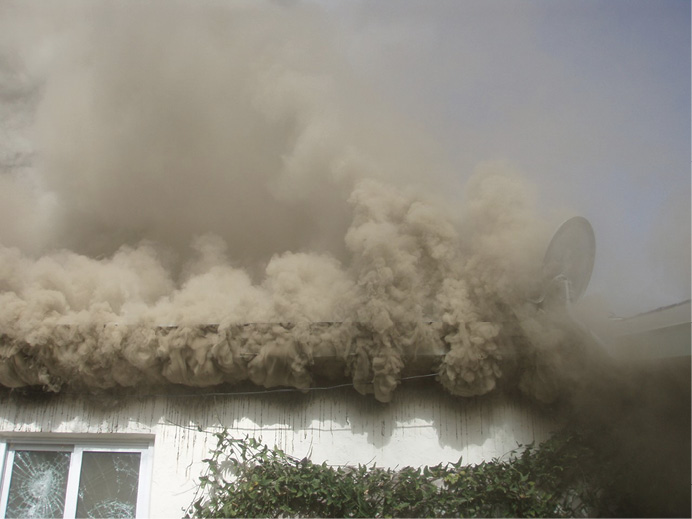
(9)
Although a ventilation chain saw equipped with a carbide-tipped chain is arguably the fastest and most effective tool for cutting laminated glass, it is practically impossible to cut a man-size opening with hand tools, especially inside a smoke-filled structure. It is possible, however, to cut small openings with hand tools to reach in and operate the latches. For example, if laminated glass windows are installed in compliance with codes, it is likely that each bedroom will be required to have one “escape” window that can be unlatched and opened from the inside. Additionally, it may be possible to open sliding and French doors in a similar fashion. Cutting with hand tools involves chopping or chiseling by striking a flathead ax with a maul.
Difficulties in Ventilation
It is rare to find a window in modern office buildings and hotels that you can open for ventilation. Some fixed sash or glass curtain wall buildings may have windows that can be opened with an Allen wrench or special key for ventilation. Similarly, older building codes required some tempered glass windows for firefighters to break. Building management does not want tenants to open windows and allow air, which is very expensive to heat, cool, and humidify, to escape. Without the ability to open a window, firefighter ventilation operations will be difficult.
Consider this common scenario: A short circuit in a power strip starts a fire under a desk in an office suite workstation or cubicle. Every window in the building is laminated glass, and none of them can be opened. Since almost everything in a cubicle is made from petrochemical-based synthetic materials (plastics), smoke produced in the beginning of the incipient stage of the fire is already dark and acrid. Soon, the fire will spread to the office chair and sound-deadening cubicle partitions, both filled with polyurethane foam and covered in vinyl or polyester fabric. Eventually the heat from the fire activates one or more sprinklers, stopping the fire’s progress but not the production of smoke.
Sprinklers rarely completely extinguish a fire, leaving it to smolder or burn incompletely. Considering that carbon monoxide (CO) is a product of incomplete combustion, the office suite is filled with dense, heavy, water-cooled smoke containing dangerous concentrations of CO. Since gasoline-powered saws will not run in a smoky, oxygen-deficient atmosphere, today’s battery-powered saws are perfect for making ventilation openings in the laminated glass windows.
The ultimate solution to ventilating buildings with fixed, insulated, impact-resistant windows is properly designed and operating smoke control systems. These consist of an elaborate array of powerful fans, large air supply and exhaust ducts, and dampers to control air and smoke movement.
Newer Battery-Powered Saws
MDFR staffs its medic rescue companies with an officer and two firefighters. These units are equipped with tools commonly found on ladder companies and, accordingly, perform ladder company functions at structure fires; they are responsible for forcible entry and search. For years, medic rescues were equipped with gasoline-powered chain and rotary saws until a concern about gasoline fumes entering the patient compartment resulted in their removal. Since the gasoline-powered saws were removed, MDFR has searched for tools to restore the rescue company’s forcible-entry capabilities, especially cutting the steel burglar bars commonly found on doors and windows in the Miami area. The department evaluated rotary and reciprocating saws powered by nickel-cadmium (ni-cad) batteries. Although these early-generation battery-powered saws could cut laminated glass in smoke-filled and oxygen-deficient atmospheres, the glass had to be “softened” by striking it with a tool, breaking the inside and outside layers of glass so that the saws essentially just cut the middle polymer core. Although portable and quick to deploy, neither of these tools came close to performing like gasoline-powered saws.
In 2019, the department had technical rescue teams (TRTs) evaluate a new generation of lithium-ion (li-ion) battery-powered cut-off saws from two manufacturers. Unlike ni-cad batteries, as li-ion batteries lose their charge, they do not decrease the tool’s power. Although they were acquired to cut steel rebar during collapse rescue operations, it was soon discovered that the new battery-powered saws cut steel burglar bars almost as fast as gasoline-powered saws. In photo 10, a firefighter is cutting steel rebar in a burglar bar cutting prop. Based on positive feedback from TRTs, the department felt confident that it had found the high-powered, portable saws it was looking for to re-equip the medic rescues. These saws have now become a “go-to” piece of equipment for a wide array of cutting challenges and have helped save lives in the process.
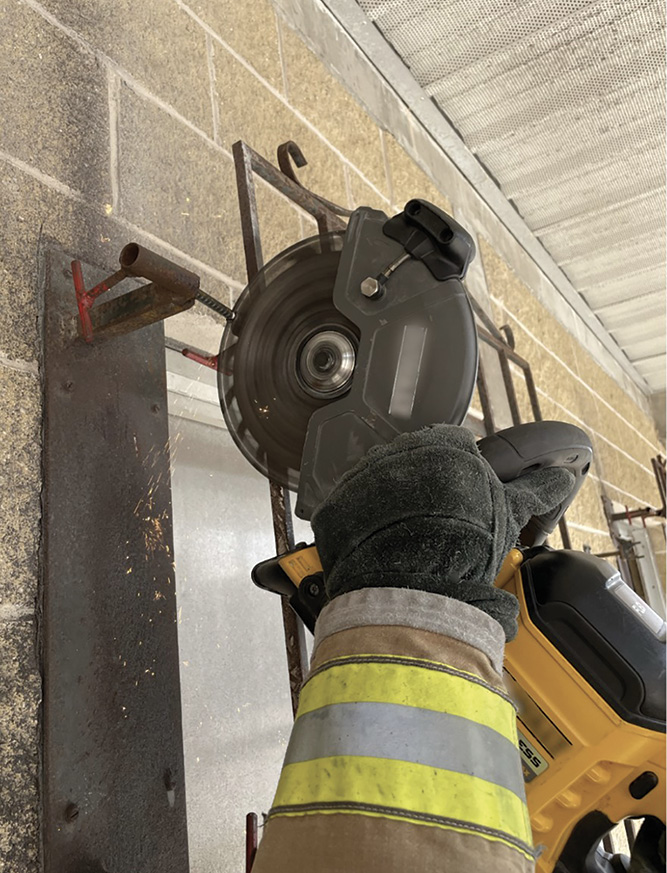
(10)
The saws are lightweight, easy to control, and rugged and work very well in tight spaces or when cutting close to victims. They excel at abrasive type cutting. During the evaluation, the department found that the best blades (technically not blades but abrasive cutting disks) for the saws are vacuum-brazed diamond-encrusted blades. Aside from the diamond edges’ cutting quality, these blades also cut with a very thin kerf; thus, the saw had less power-robbing friction than when equipped with conventional diamond-segmented blades. The blades on both brands of saws are nine inches in diameter and have a cutting depth of 3½ inches.
Each company is issued four batteries; one is kept in a charger in quarters and the others are carried with the saw. Batteries are changed in the field because either they have lost their charge or they have become overheated. As current is drawn from an li-ion battery, heat is generated; the harder and longer the saw cuts, the hotter the battery becomes until a safety circuit in the battery shuts it down. Batteries from both manufacturers have lights indicating the amount of charge available. When the lights begin flashing, it is a warning that the battery is overheating. The saws were ordered with the largest battery the manufacturers offered to increase run time and generate less heat.
Following the evaluation phase, the department developed and delivered a train-the-trainer program for medic rescue companies on how to most effectively use their newly issue saws. Medic rescue personnel would then train personnel on fire companies on cutting techniques and the capabilities and limitations of the saws.
Personnel learned that battery-powered cut-off saws do not have the power and torque they had become accustomed to with gas-powered saws. The saw from one manufacturer has a load indicator light that indicates when the saw is bogged down in a cut and the revolutions per minute (rpm) have decreased to the point that the saw is no longer efficient and the battery is in danger of overheating. Operators were taught to listen to the saw. If there is a significant drop in rpm or the blade begins to bind in the cut, lighten the pressure on the saw and reduce the speed with which the operator is pulling the saw through the cut.
Additionally, operators were taught to size up forcible-entry objectives to determine the least number of or most effective cuts to succeed. Rather than attempting to cut large openings in overhead and swinging doors, use the battery-powered saws to cut small “surgical” openings to reach and release locks and latches. For example, most commercial overhead sectional doors in South Florida are secured by sliding latches attached to the inside of the second section from the bottom. Accordingly, make a cut into the door’s sheet metal skin that is large enough to let you reach inside and release the latches. The saw’s limited depth of cut—just 3½ inches—is not a problem because the operator avoids cutting any heavy reinforcing members.
To cut deadbolts on outward swinging doors, tap an ax blade or the adz of a halligan between the door and jamb to allow the saw’s blade to spin freely. When cutting vent openings in laminated glass, make a three-sided cut across the top and both sides of the opening and pull the cut section into the building.
In photo 11, a lock cylinder is cut out of the center of a substantial steel door. The saw easily cuts the steel rods that extend from the top, bottom, and both sides of the door.
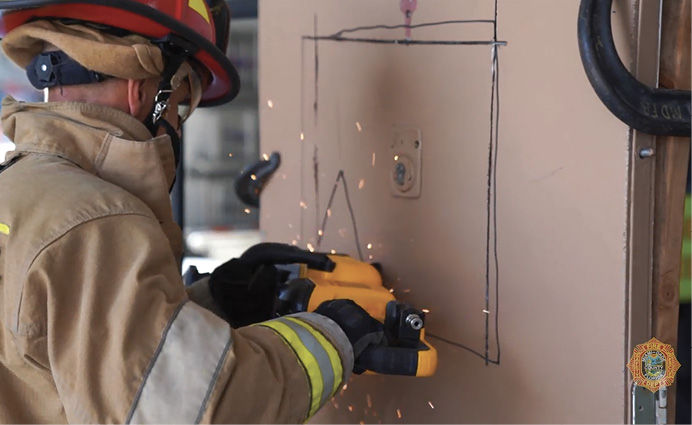
(11)
In photo 12, a battery-powered saw rapidly cuts the head of a carriage bolt in a forcible-entry prop. Because of their light weight, the saws are ideal for forcible entry inside buildings, such as cutting substantial padlocks securing the rooftop doors in stairwells.

(12)
Technical Rescue Operations
Since MDFR has acquired the li-ion battery-powered saws, personnel have used them effectively in technical rescue operations including cutting rebar during concrete-breaching operations, cutting machinery components during machinery entrapment operations, and cutting free patients involved in impalement-type rescues.
The tool industry has responded to the success of these saws in the construction and consumer tools markets. MDFR had two manufacturers to select from in 2019; now it has at least five that have construction-grade, battery-powered cut-off saws. Fire departments must evaluate all aspects of a given saw prior to selecting a particular brand. Selection criteria includes performance, cutting depth, durability, battery life, cost and availability of batteries, and manufacturer support.
Overhead Door Cutting Prop
The overhead door prop is excellent for teaching cutting techniques on scrap overhead rolling, sheet curtain, and sectional garage doors. In photo 13, the prop is used to practice cutting techniques on a household overhead sectional door. In photo 14, Miguel fabricated a heavy steel frame and fastened it to the tracks of the training facility’s overhead rolling door. An opening has been cut in a scrap overhead rolling door held in place against the frame by raker shores secured with ratchet straps.

(13)
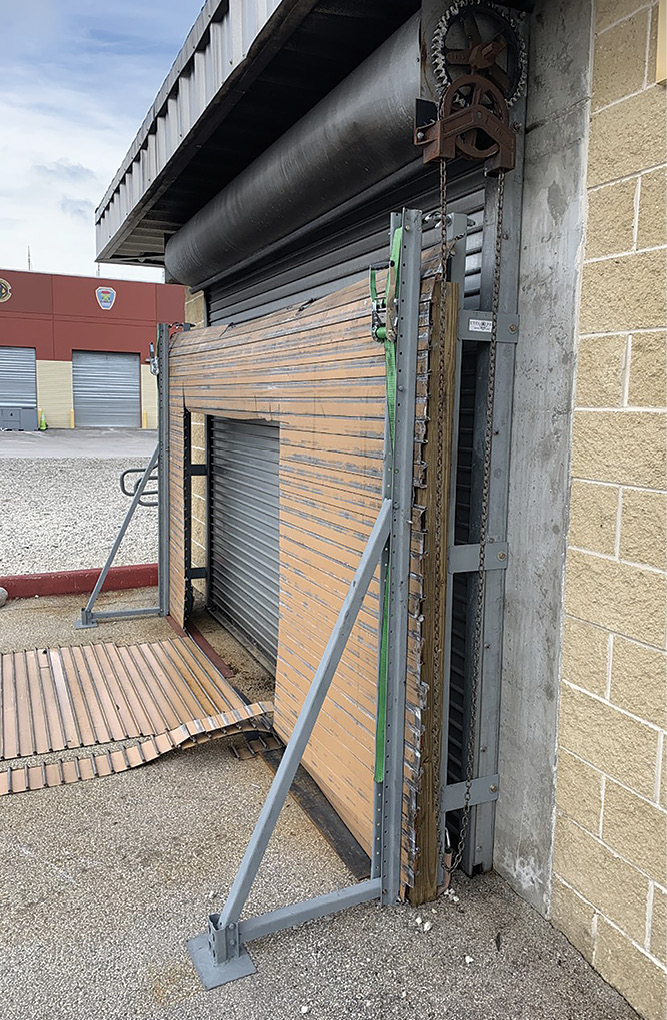
(14)
BILL GUSTIN is a 48-year veteran of the fire service and a captain with Miami-Dade (FL) Fire Rescue. He began his fire service career in the Chicago area and is a lead instructor in his department’s Officer Development Program. He teaches tactics and company officer training programs throughout North America. He is a technical editor and an advisory board member of Fire Engineering and FDIC International.
ENRIQUE PEREA is a captain and 26-year veteran of Miami-Dade (FL) Fire Rescue, where he leads the technical rescue program. He is a technical rescue technician, hazmat technician, and heavy equipment and rigging specialist with USAR FL-TF1. Perea teaches all aspects of special operations for various agencies and is a master instructor with the IAFF. He has a bachelor’s degree in civil engineering and is working toward a master’s degree in structural engineering.

